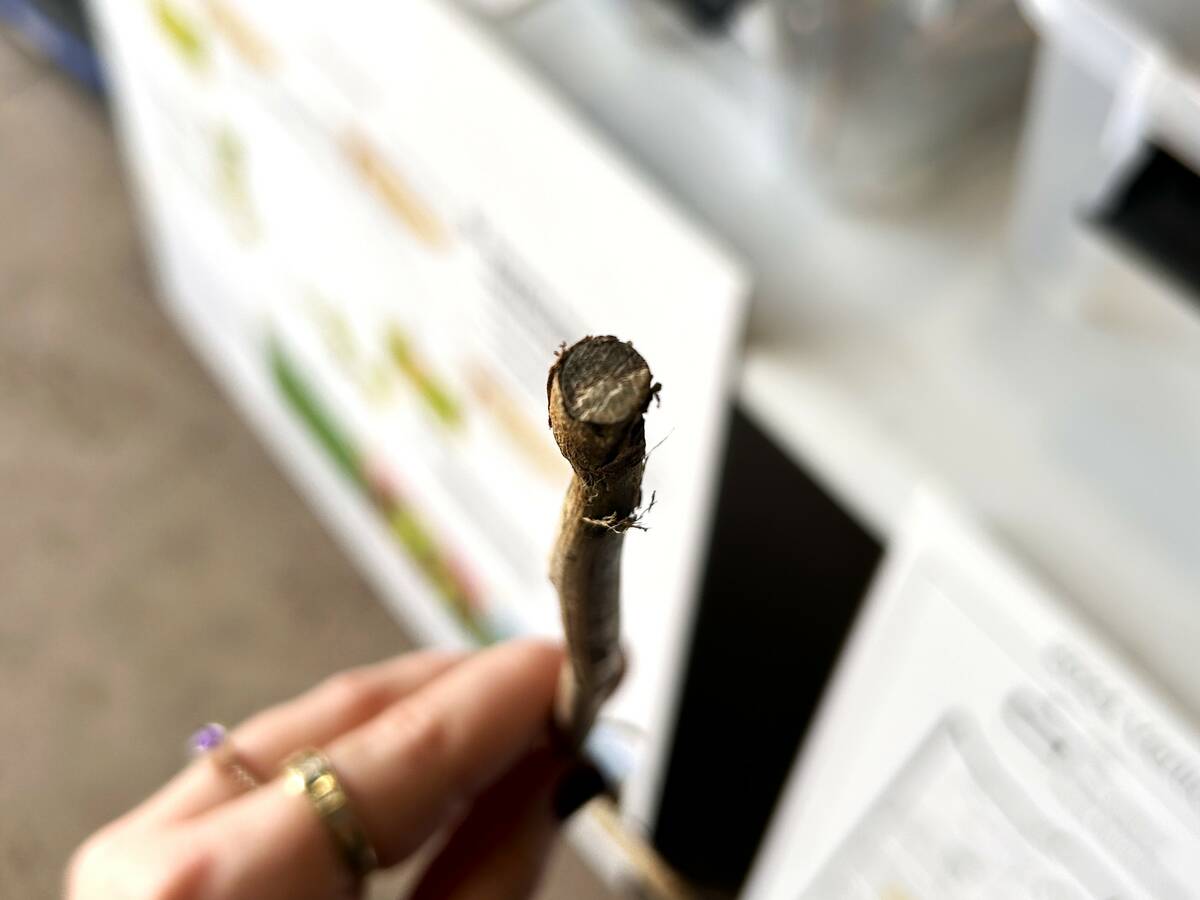Spring rain and cool conditions reawakened concerns about cereal leaf infections, say plant pathologists in Manitoba and Saskatchewan.
Variable rains in May and June in Manitoba, particularly in its central region, may have encouraged crop diseases, said David Kaminski, a field crop pathologist with Manitoba Agriculture. Some growers got enough rain to warrant a second fungicide pass, he added.
“That early season moisture led to more people observing leaf diseases on cereals than over the last several years.”
Read Also

Manitoba canola embattled by verticillium
Verticillium stripe pressure has been growing in Manitoba, and canola farmers still have precious few tools to protect their crop from the disease.
Tan spot, primarily found on wheat, is one of the most prevalent leaf diseases in Manitoba this year.
“It’s noticed early in the year because it thrives in cool conditions. Sometimes that disease will start in the lower leaves and progress right up into the upper canopy. But often, as it warms up later in the season, it stays down lower in the canopy,” said Kaminski.
Septoria complex is usually found on wheat but this year it’s been discovered in oats as well, he said.
Crown rust on oats, a common oat leaf disease in Manitoba, is being found for a couple of reasons. For one, the province is home to a shrubby plant called buckthorn, the alternate host of crown rust in oats. It grows along streams and river courses and is a source of early season infection. The other culprit is wind that blew crown rust spores from the U.S., said Kaminski.
Stripe rust, also known as yellow rust, thrives in cool temperatures. It has been reported on some spring wheat in Manitoba, which is unusual because it’s more likely to appear in Alberta on winter wheat.
Most rusts blow northward from states close to Manitoba, but an uncommon trajectory saw stripe rust spores fly into south-central Manitoba from the U.S. Pacific Northwest this spring, he said.
“So far, the development of that disease has not been substantial. It may have been curbed somewhat by warmer temperatures later on. But also, most of our spring wheat varieties have decent resistance to stripe rust. So that one is more of a curiosity than anything.”
Growers should approach rust control mindfully, said Kaminski.
“With some of the varieties that we have relied on for a number of years, there’s a resistance or tolerance that has been lost over time with all rusts. It’s a complicated life cycle, but there are sexual stages in which recombination happens. Now there’s a continual shuffling of the deck that can eventually overcome genetic resistance.”
When tackling cereal leaf or any other disease, producers should consider multiple modes of action to fend off resistance to common fungicides such as triazoles, said Kaminski. This advice may be especially pertinent to growers who need to make a second fungicide pass.
“If you have to do two applications and you’ve used a triazole at the flag leaf timing, you should seek a product that has a different mode of action later on so that you’re not using product with the same mode of action in close proximity. That’s the situation that can lead to the development of resistance in the fungal populations.”
Randy Kutcher, a plant pathologist with the University of Saskatchewan, said tan spot in wheat and net blotch in barley tend to be the most problematic for growers in that province. Durum has also attracted septoria in the past as well as bacterial leaf streak, particularly among seed growers under irrigation.
Cereal crops are usually sprayed for leaf diseases at the fully unfurled flag leaf stage. However, most crops in Saskatchewan have already passed that benchmark, said Kutcher.
Many cereal producers use one fungicide pass for fusarium head blight at flowering and hope it will also have impact on leaf diseases. Kutcher recommended that practice.
“I see there’s lots of spray tracks in some of the fields,” he said. “I would think a lot of that is for fusarium head blight, but that application of fungicide will also help to mitigate the leaf diseases to some effect. Generally, we like to hit the leaf diseases a little earlier.”
The flowering period depends on when the crop was seeded. The cool, wet spring interfered with seeding in some areas so timing may vary, said Kutcher. Regardless, it’s nice to have moisture.
“We’ve had quite a number of dry years. so I think everybody’s pretty happy. We’ve had a bit of replenishment of moisture in the soil and pretty good growing conditions.”
Leaf disease control options are limited at this point, since they start with oft-recommended integrated management considerations: diverse rotations, scouting and varietal choice.
“To me, rotation is number one,” said Kutcher. “Wheat-canola is not a diverse rotation. You’re probably going to have to put more inputs into it. You’re going to have more disease if you grow wheat every second year.”
Adding a pulse, flax or oat crop for at least a three-year rotation can limit the amount of disease pathogens, he said. Ideally, the more crops in rotation, the better.
“In the past, when I’ve worked on studies where we had six different crops in six different years, there’s not a whole heck of a lot for pathologists to do generally. But if you’re going to grow wheat-canola or lentil-durum, then there’s usually a lot of work for pathologists.”
Growers’ varietal choice can be made easier by paying attention to resistance ratings for a disease. All three Prairie provinces publish these ratings for a local perspective.
Said Kaminski: “We have an excellent publication here in Manitoba called Seed Manitoba, and in it you can find tables that delineate their resistance to specific diseases. I think tan spot and septoria are lumped together simply as leaf diseases but the rusts and head blight have the ratings for those resistance categories.
















